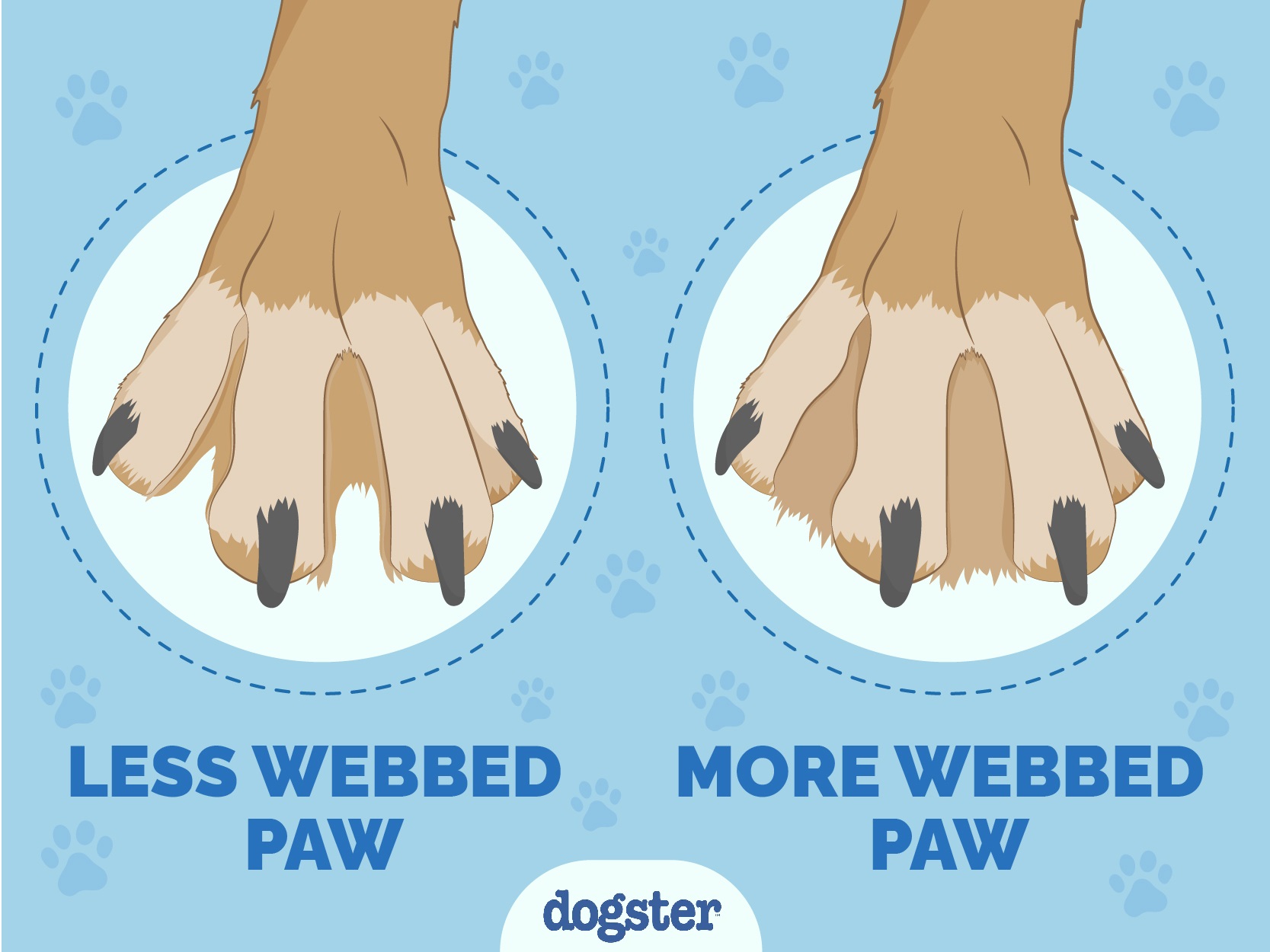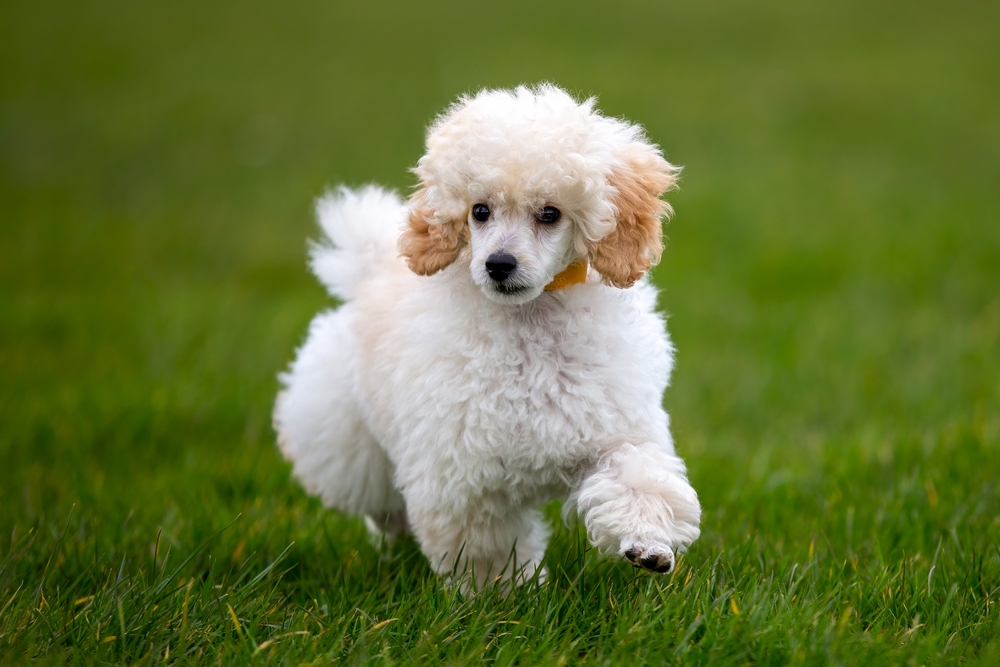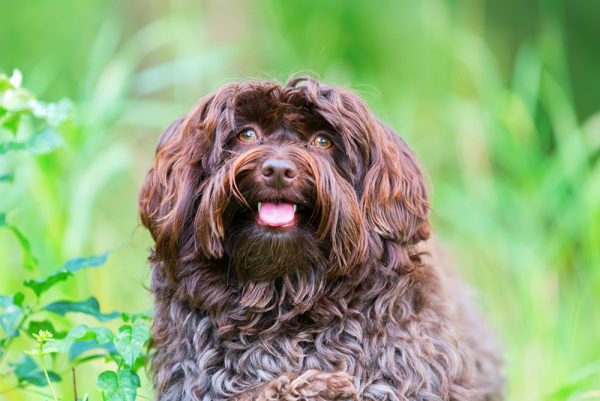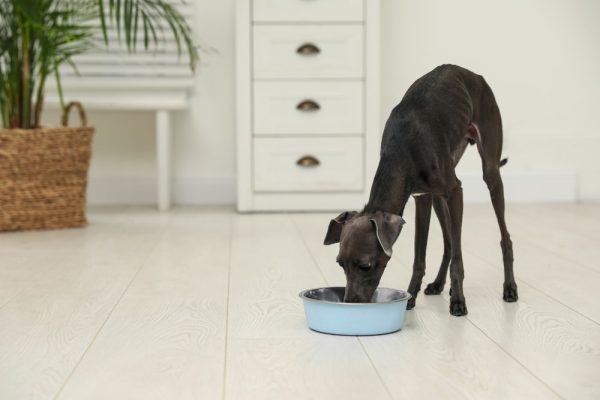In this article
When you think about animals with webbed feet, dogs aren’t likely the first species to come to mind. Believe it or not, all dogs have some webbing between their toes. This thin skin is similar to the skin between our fingers. Depending on the breed, some dogs have a little more.
So do all dogs have webbed feet? Not every dog breed possesses truly webbed feet like a duck, but some do! Read on to learn more about dogs with webbed feet and why some breeds have this.

Why Dogs Have Webbed Feet

All dogs are born with webbed feet, but some grow out of this trait before adulthood. Breeds developed near water or for water-related tasks are more likely to retain their webbed feet than landlocked dogs. The webbing in between their toes helps them swim. It connects their digital pads, similar to how swimmers cup their hands as they pull a stroke.
However, there are some exceptions to the norm. For example, the Dachshund was strategically bred to have webbed feet because they were tasked with hunting badgers, which required a lot of digging. Breeds developed to highlight their strength or agility are the least likely to have this feature.
The webbing can impair their ability to run on land, which is one reason you won’t find it in some of the fastest breeds, such as the Greyhound or Whippet. Dogs historically used to pull sleds, such as Huskies and Malamutes, retain some webbing, but not as much as water dogs. Other breeds that weren’t developed for manual labor, such as the Maltese, don’t have webbed feet.

The 8 Breeds of Dogs With Webbed Feet
Are you curious to see if your dog makes the cut? Here’s a list of popular breeds with webbed feet. It’s not an exhaustive list, but it highlights some canines you’re likely to encounter next time you go to the dog park.
1. Poodle

| Height: | 18–24 inches |
| Weight: | 45–70 pounds |
| Lifespan: | 12–15 years |
| Colors: | Black, white, brown, apricot, silver, cream, red, grey |
| Suitable for: | Active families with children |
| Temperament: | Intelligent, energetic, affectionate, loyal |
The standard Poodle always has webbed feet and was developed to retrieve waterfowl. Although their smaller counterparts (toys and miniatures) may not share their sporting interests, they have webbed feet. Poodle hybrids may also have webbed feet depending on which parent the puppy takes after.
For example, a Goldendoodle may or may not possess this interesting feature since the Golden has separated toes. If you have a Labradoodle, you’re in luck since both breeds share this amazing trait.
2. Labrador Retriever

| Height: | 21.5 – 24.5 inches |
| Weight: | 55 – 80 pounds |
| Lifespan: | 11 – 13 years |
| Colors: | Yellow, chocolate, black |
| Suitable for: | Active families or singles, house with a yard |
| Temperament: | Energetic, lovable, friendly, playful, outgoing, smart |
Hailed as America’s most popular dog for 30 consecutive years, the Labrador Retriever has been championed as the ideal companion for active families and sportsmen. They love the water and will rarely turn down a swim. Labrador hybrids may or may not have webbed feet depending on which genes are passed to the offspring.
3. Irish Water Spaniel

| Height: | 21 – 24 inches |
| Weight: | 45 – 68 pounds |
| Lifespan: | 12 – 13 years |
| Colors: | Brown, chocolate, liver |
| Suitable for: | Families with children, families with other dogs, active lifestyles |
| Temperament: | Affectionate, easygoing, intelligent |
The Irish Water Spaniel breed looks like a Poodle but has longer ears and a distinctive rat tail. Unlike the Poodle, Irish Water Spaniels always have brown hair. Interestingly, they are the tallest Spaniel recognized by the AKC and are also suspected to be the oldest.
4. Portuguese Water Dog

| Height: | 17–23 inches |
| Weight: | 36–60 pounds |
| Lifespan: | 11–13 years |
| Colors: | Black, white, brown, black & white, white & chocolate |
| Suitable for: | Active families, people who enjoy spending time outside, experienced dog owners |
| Temperament: | Loving, independent, intelligent, eager, affectionate |
Not surprisingly, this stellar swimmer was named for their skills in the water. Portuguese Water dogs have been the fishermen’s best friend for hundreds of years. Their tight curls and webbed feet suit them for their job.
5. Newfoundland

| Height: | 26 to 30 inches |
| Weight: | 100 to 150 pounds |
| Lifespan: | 8 to 10 years |
| Colors: | Black and white, black, brown, gray, tan, beige |
| Suitable for: | Active singles or families with or without kids, those who don’t mind dog hair |
| Temperament: | Loyal, loving, intelligent, easy to train, friendly |
Since they were raised to be the fisherman’s lifeguard and companion, the Newfoundland is a giant breed strong enough to save an adult from drowning. Their webbed feet give them extra power to glide through the water with grace. Despite their large size, they have a gentle temperament and are an ideal family dog.
6. Dachshund

| Height: | 8–9 inches (standard) 5–6 inches (miniature) |
| Weight: | 16–32 pounds (standard) 11 pounds or less (miniature) |
| Lifespan: | 12–16 years |
| Colors: | Black, chocolate, fawn, or blue with tan, cream, wheaten, wild boar, red, black, fawn, chocolate, or blue with cream |
| Suitable for: | Families and individuals with patience and previous experience owning dogs, families with older kids |
| Temperament: | Independent, playful, bold, protective, charming, sometimes stubborn |
The badger Hound’s connected toes help them dig deeper into the ground. Historically, this characteristic enabled them to hunt with ease. In modern times, though, it might pose a threat to your lawn. Although they might not gravitate towards water like the Labrador, some Dachshunds might like to swim.
However, they probably won’t be able to swim laps very quickly since their short legs impair their ability to make large strokes.
7. German Short-Haired Pointer

| Height: | 21 – 25 inches |
| Weight: | 45 – 70 pounds |
| Lifespan: | 10 – 12 years |
| Colors: | Liver, liver and white, liver roan, black, black and white, black roan |
| Suitable for: | Active, experienced dog owners, families with older kids |
| Temperament: | Energetic, friendly, smart, eager, good with kids, a bit stubborn |
German Short-Haired Pointers excel on land and water, given their excellent swimming and tracking skills. Bred to hunt birds, they’re equipped with speed, agility, and athletic ability that makes them a modern-day master of dog sports.
8. Redbone Coonhound

| Height: | 21–27 inches |
| Weight: | 45–70 pounds |
| Lifespan: | 12–15 years |
| Colors: | Red |
| Suitable for: | Active families, sportsmen |
| Temperament: | Even-tempered, mellow, friendly, hardworking |
Although they recently joined the AKC in 2009, the Redbone Coonhound descends from a long line of southern hunting dogs that have been nosing around the swamps since the 1700s. Their webbed feet allow them to tread on soggy ground without sinking, which is helpful for hunting waterfowl.

Conclusion
All dogs have webbed feet, but most breeds lose some of the connective tissue before reaching adulthood. Dogs traditionally developed around water or for water-related tasks, such as the Newfoundland, are likelier to possess the trait. Sledding dogs are a group that retains more webbing than non-sporting companion breeds, such as the Havanese, but not as much as breeds that thrive in the water.
Featured Image Credit: JakubD, Shutterstock


















